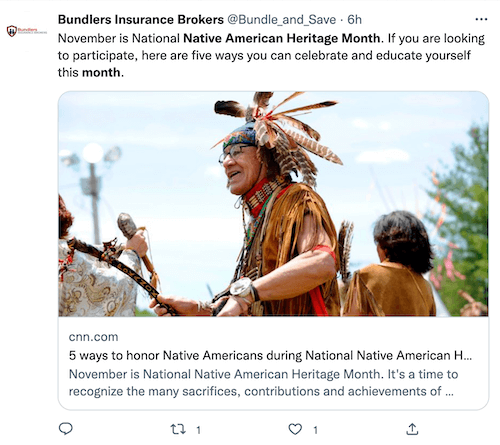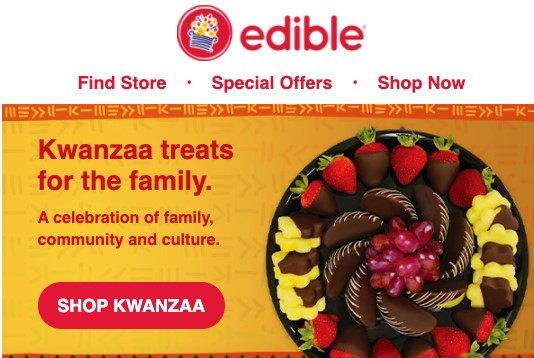PPC
45+ Inclusive Holiday Marketing Ideas (+Examples!)

Diverse and inclusive marketing should be something you aim for year-round. However, it’s all that much more important during the holiday season as the more “traditional” holidays like Christmas and Thanksgiving take the spotlight.
There’s nothing wrong with celebrating these holidays and incorporating them into your marketing, but there are other groups and events that individuals in your audience appreciate.

A marketing calendar like this can help you plan your inclusive holiday marketing.
That’s why we’ve rounded up over 40 inclusive holiday marketing ideas and examples so your business can shine bright this season.
Table of contents
Jump to inclusive marketing ideas for…
Inclusive November holiday marketing ideas & examples
To kick things off, check out these inclusion-focused marketing ideas for November:
Native American Heritage Month
If you’re hoping to incorporate Native American Heritage Month into your diversity, equity, and inclusion efforts this season, you’ll be in good company as The Library of Congress, National Archives and Records Administration, National Endowment for the Humanities, National Gallery of Art, National Park Service, Smithsonian Insituation, and the U.S. Holocaust Memorial Museum all regularly pay homage to this November monthly observance.
Native American Heritage Month is observed annually every November, and it celebrates the contributions the first Americans made towards the growth of the United States. It also honors and reflects on the struggles indigenous American people have endured.


National Day of Mourning
A historically accurate description of Thanksgiving would include the reality of its damaging impact on Native American people, which is why we have the National Day of Mourning every year on Thanksgiving—to remind us of the pain Native American people have gone through, and still may be feeling today.
Here are some ideas for ways your business can pay its respects to Native American Heritage Month as well as the National Day of Mourning:
- Amplify the voices of Native Americans by handing off your Instagram account to a Native American in your community for a day-long “takeover.” They can then go live on your stories or share posts about what Native American Heritage month means to them.
- Loop Native American Heritage month and the National Day of Mourning into your Thanksgiving messaging by sharing more concious content around the holiday’s impact on Native American people.
- Check out the free Native American Heritage Month resources on the U.S. Small Business Administration website. There you can find statistics to share, lists of Native American-Owned businesses to partner with, and more.
- Spread awareness using a social media hashtag. The official hashtag for Native American Heritage Month is #NAHM.


National Adoption Month
There is always a lot of messaging around family during the holiday season, which makes it particularly important to stay mindful of those with non-traditional families. National Adoption Month, celebrated every November to bring awareness to children in foster care, provides an opportunity for this. Here are some ways to incorporate it into your holiday marketing campaigns:
- Avoid using traditional parent roles in your holiday copywriting, like “mom” and “dad” which may make your audience members who don’t have that type of parental figure feel excluded.
- Adjust your content to be more sensitive to those with different family structures. For example, instead of promoting an event as a “family fun day,” try “friends and family fun day” or “festival fun day.”
- Highlight a superstar adoption story in your business’s community. If you have an employee, friend, or community member who was part of an adoption process, ask to share their story to showcase how they inspire your business during this month and beyond.
- Raise awareness about adoption within minority groups. For example, did you know that adoptions done by LGBTQ+ couples only became legal in all 50 states just a few years ago in 2017?


❤Find the right words for your inclusive holiday marketing copy using our free guide to emotional copywriting complete with over 130 words and phrases for marketing with emotion.
Day of the Dead (November 1-2)
Day of the Dead, also known as Dia de los Muertos, is a Mexican holiday that honors the soulds of the deceased. It’s a two-day celebration that starts every year on November 1 and carries into November 2. This colorful and fun holiday is believed to open the passageway between the real world and the spirit world in traditional Mexican culture, so many people of Mexican descent feel they can connect with their loved ones who have passed during this time.
Nearly 20% of the U.S. population is of Mexican heritage, so you’ll likely have audience members who celebrate Day of the Dead. Make your Mexican audience members feel included in your holiday marketing with these ideas and examples:
- Share fun facts or hold a virtual trivia event centered around Day of the Dead to spread the word about the holiday’s traditions.
- Decorate your store or office with traditional Day of the Dead skulls, flowers, and more. Be sure to snap a picture of your temporarily updated decor so you can share it on your company website or social media platforms.
- Honor those who have passed. Have you or an employee ever lost a friend or loved one you’d like to commemorate? Day of the Dead is the perfect opportunity to do so! You could share their story on social media to give your audience a more personalized perspective of your business.


Forget-Me-Not Day (November 10)
Having been around since World War I, Forget-Me-Not Day happens annually on November 10 — right before Veteran’s Day on November 11. Forget-Me-Not Day is meant to honor and remember wounded soldiers who have become disabled due to their time fighting for our freedom.
The number of veterans who carry the weight of service-related physical and mental hardships is very high. In fact, counting only wars from 2001 and beyond still amounts to about 1.5 million veterans in America with a service-connected disability. While wounded veterans should be remembered every day, here’s how your marketing can honor them on Forget-Me-Not Day:
- Donate your time, resources, or (if your marketing budget allows) money to a local Veteran’s organization or shelter.
- Be mindful of your veteran (and civilian) customers who have a disability by focusing on your website accessibility. Take time to ensure your site is easy to navigate regardless of what assistance someone might need. If you’re not sure where to start, check out this complete website accessibility checklist.


Women Entrepreneurs Day (November 19)
Only four out of every ten entrepreneurs in the U.S. are women. Women Entrepreneurs Day, occurring annually on November 19, aims to change that.
This inclusive holiday is much needed, as America is still far behind other countries in terms of women entrepreneurs. In comparison, women represent 50% of entrepreneurs in Latin America and the Caribbean. Here’s how your business can make an impact with this holiday:
- Share surprising statistics about women entrepreneurs through an email marketing campaign or social media post. These are sure to engage your audience while spreading awareness. You can find plenty of diversity, equity, and inclusion in marketing statistics here.
- Partner with a woman-owned business. You could cross-promote one another in-store or online, and offer samples or discounts on each other’s offerings.
- Support the Women’s Entrepreneurship Day Organization. Also known as WEDO, this organization acts as a hub for Women Entrepreneurs Day. On its site you’ll find many ways to elevate your marketing for the day, including events you can attend, ways to donate, custom hashtags, surprising statistics, inspiring stories, and more!


Transgender Day of Rememberance (November 20)
Transgender Day of Rememberance occurs annually on November 20 to honor and remember transgender people who lost their lives due to anti-transgender violence. It started in 1998 in memory of Rita Hester, a transgender woman who was stabbed in Allston, Massachusetts that same year.
This inclusive holiday is important to acknowledge because, sadly, these acts of violence are still occuring as 2020 was the most violent year on record for transgender people. Your business can become a transgender ally on Transgender Rememberance Day and beyond with these ideas:
- Donate or volunteer to a local LGBTQ+ organization.
- Spread awareness and acceptance by openly sharing your allyship on your website, social media, local listings, and more.
- If you have an employee, family member, friend, or community member who is openly transgender you could ask their permission to highlight their story in an email send or social post.
- Amplify transgender voices by resharing public speeches, posts, and more from transgender people. You could even handing off your “mic” by allowing a transgender person in your business’s community to do a social media takeover.


Inclusive December holiday marketing ideas and examples
Here are some December marketing ideas that will help you to embrace diversity and inclusion:
Rosa Parks Day (December 1)
Rosa Parks Day is celebrated twice annually, once on December 1 and once on February 4. This inclusive holiday is to, of course, honor civil rights hero and leader Rosa Parks.
The Rosa Parks story is one no American citizen can forget, as she bravely did not give up her seat to a white passenger after a long day of work on December 1, 1955. This action jumpstarted the Montgomery Bus Boycott organized by E.D. Nixon, Dr. Martin Luther King, Jr., and other civil rights leaders at the time. Here’s how your business can observe Rosa Parks Day:
- Encourage your audience to educate themselves on Rosa Parks and the Civil Rights movement by sharing with them your favorite books around the era. For example, Rosa Parks herself wrote a couple of books, including Rosa Parks: My Story and Quiet Strength: The Faith, The Hope, and the Heart of a Woman Who Changed a Nation.
- Partner with a black-owned business in your community and run a joint campaign themed around civil rights and standing up (or sitting down) for what you believe in.
- Run a Rosa Parks-themed giveaway. There is a Rosa Parks museum at Troy University in Alabama. You could entice your audience to enter to win free tickets to the museum or do a full-on sweepstake by offering a complete trip to tour the museum.


Human Rights Day (December 10)
Inclusivity means making sure all types of people feel like they belong, regardless of race, religion, gender, sexual orientation, abilities, etc. That’s why Human Rights Day (occurring on December 10 each year) is the perfect holiday to incorporate into your inclusive marketing this season.
Human Rights Day was created by the UN in 1948 to proclaim the rights everyone is entitled to as a human being “regardless race, color, religion, sex, language, political or other opinions, national or social origin, property, birth or other status.” Show your audience you support the rights of all people with these Human Rights Day marketing ideas:
- Attend a human rights event and share a recap of your experience with your audience to inspire them to do the same. There are plenty of political summits, cultural conferences, and more held on Human Rights Day, so simply being present at an event in your community can spread awareness and inspiration.
- Create a shareable, public playlist of your favorite songs about human rights. There are plenty of inspiring songs your audience will want to listen to, so you could simply build a quick list on a platforms like Pandora, Spotify, Soundcloud, and more. Be sure to include your business name in your playlist’s title so that your audience will think of your brand as they listen. As a bonus, you could have the playlist play for the day in your store or office, and share a quote from one of your top songs on social media.


Hanukkah
Also known as the Festival of Lights, Hanukkah is an eight-day Jewish celebration. The dates of Hannukah change each year as it starts on the 25th day of Kislev according to the Hebrew calendar. Hanukkah traditions include lighting a menorah, exchanging gifts, and enjoying cultural cuisine like latkes (potato pancakes). Over 5% of Americans celebrate Hannukah, so here’s how your business can take part:
- The best part of any holiday? The food! Try sharing a traditional Hanukkah recipe on various marketing channels.
- If you’re decorating your office or store for Christmas, stay mindful of those who celebrate Hanukkah as well by including a menorah, dreidels, and more in your display.
- Use our Hanukkah Instagram captions for post inspiration.
- Play off the eight days of Hanukkah by writing a blog post or email that shares eight tips or eight top products for your audience to check out.


Speaking of email, do you have your annual holiday customer appreciation email written? If not (or even if you do), don’t miss our heartfelt holiday email templates.
Kwanzaa (December 26 – January 1)
Kwanzaa is a seven-day African American holiday that occurs annually from December 26 to January 1. Each day of the celebration is dedicated to the following seven cultural principles: unity, self-determination, collective responsibility, cooperative economics, purpose, creativity, and faith. Work the values of Kwanzaa into your inclusive holiday marketing plan with these ideas:
- Focus on one of the seven Kwanzaa principles and share with your audience how your business strives to embody it. For example, you could incorporate unity or collective responsibility into your video marketing strategy by giving your audience a behind-the-scenes look at the teamwork of your employees.
- As you decorate your store or office for Christmas and Hanukkah, be sure to include Kwanzaa as well. For example, each day of Kwanzaa requires one of seven candles to be lit — which are in an arrangement called a Kinara. You could add a Kinara to your decor, or include other Kwanzaa decorations like traditional African crops such as ears of dried corn and more.
- Try out any of these Kwanzaa Instagram captions.
- Add a twist to one of your products or offerings and refresh it for the Kwanzaa season by changing its name or colors.


Inclusive January holiday marketing ideas and examples
Some of the “bigger” holidays may be over by the time January comes around, but there are still plenty of diverse holidays you can leverage in your inclusive marketing strategy this month:
National Braille Literacy Month
January is Braille Literacy Month because Louie Braille, the creator of the braille system, was born in January. This monthly observance is meant to bring awareness to those who are visually impaired. Here’s how your business can take part in National Braille Literacy Month:
- Audit your website for visual accessibility features and optimize where you can to cater to your visually impaired audience members.
- Share fun facts about the braille system to entertain your audience while spreading awareness of the need for braille literacy. For example, did you know that Braille is primarily created by just six dots? And, there are separate codes used for music, math, walkways, and more!


Dr. Martin Luther King Jr. Day (January 15)
Dr. Martin Luther King Jr. Day occurs on the third Monday of every January to commemorate his birthday on January 15. It’s no secret that Dr. King played one of the most impactful roles in American history as he helped lead the civil rights movement. In fact, this holiday is also often called Civil Rights Day, since Dr. King had such an influence on the civil rights movements during the 1950’s, 1960’s, and beyond. Dr. King’s legacy still resonates today as we continue to strive for equality across the nation. Celebrate Dr. Martin Luther King Jr. with these ideas:
- Share an inspiring story or quote from Dr. King’s life to celebrate his work with your audience.
- Lead by example by embodying Dr. King’s principle of peaceful protest. Is there a cause in your community or industry that you feel passionate about? Hold a peaceful in-person or virtual event to discuss the topic with your brand’s community members.


National Religious Freedom Day (January 16)
National Religious Freedom Day is celebrated each year on January 16 because the Statute for Religious Freedom was signed on January 16, 1786. This statute created the base for the core principles our country still stands by to this day, and guaranteed freedom to practice any desired religion is one of the privelages Americans rely on. Show how your business cares this holiday season by implementing these Religious Freedom Day marketing ideas:
- If you’re using stock photos on your website, social media, Google Ads campaigns, and other marketing materials, try to ensure you’re using diverse visuals to embrace religious freedom. For example, you might try to include images of women wearing hijabs, or men wearing kippahs or yarmulkes. We share more tips on inclusivity in advertising here.
- Join a National Religious Freedom Day online discussion to share the religion you practice and encourage your audience to do the same. If you don’t currently practice any religion, that’s okay too! Acknowledging the norm that everyone’s religious journey (or lack thereof) is different will be the point of this inclusive marketing idea. Plus, you’ll be building your brand community as you foster an open discussion with your audience.
- Educate your audience on their religious freedom rights by sharing out resources on laws and regulations relating to religious freedom.


💡 Make the most of these inclusive marketing holidays with our guide to the 30 best ways to promote your business year-round.
International Day of Acceptance (January 20)
International Day of Acceptance is fairly new as it was established back in 2010. It was created to foster social acceptance for those with disabilities. International Day of Acceptance happens every year on January 20 and reminds us that people should feel comfortable to be who they are regardless of their varying abilities. Here are some inclusive holiday marketing ideas you can leverage on this day and beyond to make your audience feel more accepted:
- Promote a new product or service offering that’s tailored to the needs of those with disabilities.
- Share helpful resources for your customers to educate themselves on disabilities, acceptance, and allyship.
- Spread the word of this inclusive holiday on social media with the hashtag #dayofacceptance and implement the symbol of acceptance (a wheelchair intertwined with a heart) in your creative elements.


Chinese New Year
Many people assume the holiday festivities end on December 31, but the Chinese New Year keeps the celebrations going since it happens shortly after, between January 21 and February 20 depending on the Chinese Lunar Calendar. The public holiday will last for seven days, but celebrations can go on for 16 days.
Try out these Chinese New Year celebration ideas:
- Share the Chinese zodiac chart on your website or social media so that your audience can check out what their own chinese zodiac would be. For example, 2023 will be the year of the rabbit. Perhaps it will be a special year for some of your customers whose birth year aligns with the rabbit!
- Use our New Year’s Instagram captions to publish engaging and thought-provoking posts.
- Partner with a local Chinese-owned business and offer a special deal to patrons of both your businesses during Chinese New Year.


Make your holiday marketing more inclusive this year
It’s super important to recognize beliefs and perspectives other than our own and to give a voice to minority groups—and clearly, there are endless ways you can demonstrate diversity, equity, and inclusion during the holiday season. So be sure to use these inclusive marketing ideas and examples as inspiration to ignite your own holiday promotions.
To recap, here are the holidays and observances we covered:
- November
- Native American Heritage Month
- National Adoption Month
- Day of the Dead (November 1-2)
- Forget-Me-Not Day (November 10)
- Women Entrepreneurs Day (November 19)
- Transgender Day of Rememberance (November 20)
- December
- Rosa Parks Day (December 1)
- Human Rights Day (December 10)
- Hanukkah (changes annually)
- Kwanzaa (December 26 – January 1)
- January
- National Braille Literacy Month
- Martin Luther King Jr. Day (January 15)
- National Religious Freedom Day (January 16)
- International Day of Acceptance (January 20)
- Chinese New Year (changes annually)
If you’re looking for more resources on growing your business during the holidays, check out these posts:

















